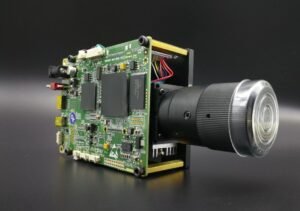Neural Networks Definition
The concept of neural networks has gained significant popularity in recent years thanks to advancements in machine learning and artificial intelligence. Neural networks, also known as artificial neural networks (ANNs), are a type of computational model inspired by the structure and functionality of the human brain. They are composed of interconnected nodes (or “neurons”) that process and transmit information to solve complex tasks.
Key Takeaways:
- Neural networks are computational models inspired by the human brain.
- They are composed of interconnected nodes called neurons.
- Neural networks are used in machine learning and artificial intelligence.
Neural networks mimic the behavior of the human brain by using a system of interconnected “neurons” or nodes. Each neuron receives input data, processes it using an activation function, and then transmits the output to other neurons in the network. These connections allow the network to learn from large amounts of data and make predictions or decisions based on patterns and relationships identified in that data. *Neural networks can be trained to recognize complex patterns that might be difficult for humans to perceive.*
How Neural Networks Work
Neural networks work by creating a mathematical model of the problem at hand, dividing it into multiple layers of interconnected neurons. The first layer, usually called the input layer, receives the initial data. The last layer, known as the output layer, provides the final predictions or decisions. In between, there can be several hidden layers that help transform the input data into a useful form.
Each connection between neurons in the network is associated with a weight, which determines the strength of the connection. During the training process, the network iteratively adjusts these weights based on the differences between the predicted output and the actual output. This learning phase, often called backpropagation, allows the network to improve its performance by minimizing the error between its predictions and the desired outcomes. *By learning from examples, neural networks can generalize their knowledge and make accurate predictions on new, unseen data.*
Types of Neural Networks
There are several types of neural networks, each with its unique architecture and specific use cases. Here are some common types:
- Feedforward Neural Networks: These networks have connections that only flow in one direction, from input to output, without loops or cycles. They are used for simple tasks like classification and regression.
- Recurrent Neural Networks (RNNs): RNNs have connections that form a directed cycle, allowing them to have memory and process sequential data. They are commonly used in tasks like speech recognition and language modeling.
- Convolutional Neural Networks (CNNs): CNNs are specifically designed for image processing tasks. They use convolutional layers to perform automated feature extraction from images, making them effective in tasks like object detection and image classification.
- Long Short-Term Memory (LSTM) Networks: LSTM networks are a type of RNN that can better handle longer sequences by alleviating the vanishing gradient problem. They are often used in tasks involving natural language processing and time-series analysis.
Advantages and Limitations
Neural networks have various advantages and limitations that make them suitable for certain applications and challenging for others. Let’s explore some of these:
| Advantages | Limitations |
|---|---|
| Ability to learn from large amounts of data | Need for considerable computational resources |
| Ability to recognize complex patterns | Prone to overfitting if not properly regularized |
| Effective in processing unstructured data | Interpretability of results can be challenging |
Applications of Neural Networks
Neural networks have found applications in various fields. Here are a few notable examples:
- Image and speech recognition: Neural networks have revolutionized image and speech recognition tasks, allowing for highly accurate automatic identification and transcription.
- Medical diagnosis: Neural networks are utilized to analyze medical data, assisting in the diagnosis of diseases and the prediction of patient outcomes.
- Financial analysis: Neural networks can analyze complex financial data, identify patterns, and make predictions for stock market trends, risk assessment, and fraud detection.
- Natural language processing: Neural networks power language translation, sentiment analysis, chatbots, and other tasks related to human-language understanding.
Conclusion
Neural networks, inspired by the human brain’s structure and functionality, have become a powerful tool in the fields of machine learning and artificial intelligence. Their ability to learn from large amounts of data and recognize complex patterns makes them invaluable in solving a wide range of tasks. From image recognition to medical diagnosis and financial analysis, neural networks continue to advance and influence numerous industries.

Common Misconceptions
Neural Networks are similar to the human brain
One common misconception about neural networks is that they work exactly like the human brain. While neural networks are inspired by the structure and function of the human brain, they are not identical. Here are three points to consider:
- Neural networks are designed to solve specific problems, whereas the human brain is capable of performing a wide range of cognitive tasks.
- Neural networks rely on mathematical algorithms and statistical models, whereas the human brain is more complex and incorporates additional factors, such as emotions and memories.
- While neural networks can process vast amounts of data quickly, the human brain has remarkable adaptability and learning capabilities.
Neural Networks always provide accurate results
Another misconception is that neural networks always deliver accurate results. However, there are several factors that can influence the accuracy of neural networks. Consider the following:
- The quality and size of the training data used to train the neural network can impact its accuracy.
- The architecture and parameters of the neural network need to be carefully designed and tuned to achieve better accuracy.
- Neural networks can suffer from overfitting, where they perform well on the training data but fail to generalize to unseen data.
Training a neural network is a straightforward process
Many people assume that training a neural network is a straightforward process. However, it can be quite complex and time-consuming. Here are three key points to consider:
- Choosing the right architecture for the neural network requires expertise and experimentation, as different architectures work better for different tasks.
- Training a neural network typically requires a large dataset and significant computational resources.
- Tuning the hyperparameters of the neural network, such as learning rate and regularization, is a trial-and-error process that involves careful analysis and experimentation.
Neural Networks can replace human intelligence
Many people have the misconception that neural networks will eventually replace human intelligence. However, this is an unfounded fear. Consider these points:
- Neural networks excel in specific tasks, such as image classification or speech recognition, but they lack general intelligence and common sense reasoning.
- Human intelligence involves a combination of cognitive abilities, emotions, creativity, and social interactions, which cannot be fully replicated by neural networks.
- Neural networks are tools that can enhance human intelligence and improve decision-making, but they are not a substitute for human intelligence.
Neural Networks are only used in advanced technologies
Lastly, there is a misconception that neural networks are exclusively used in advanced technologies. However, they have applications in various fields. Consider these points:
- Neural networks are used in finance for predicting markets and managing risk.
- In medicine, neural networks can assist in diagnosing diseases and analyzing medical images.
- Neural networks are utilized in recommendation systems to personalize content and improve user experiences.

Table: Neural Networks Applications in Healthcare
Neural networks have become increasingly prevalent in healthcare settings. This table demonstrates the various applications of neural networks in the medical field.
| Application | Description |
|---|---|
| Medical Image Analysis | Neural networks can be used for the detection and diagnosis of diseases from medical images, such as X-rays and MRIs. |
| Drug Discovery | Neural networks help in the identification and design of new drugs by analyzing vast amounts of molecular data. |
| Disease Prediction | By analyzing patient data, neural networks can predict the likelihood of developing certain diseases, enabling early intervention. |
| Genetic Analysis | Neural networks assist in analyzing genetic data to understand complex genetic disorders and patterns. |
| Medical Records Organization | Neural networks aid in organizing and classifying medical records, ensuring easy access to patient information. |
Table: Neural Networks vs. Traditional Algorithms
Comparing neural networks with traditional algorithms can help us understand the advantages and limitations of both approaches.
| Aspect | Neural Networks | Traditional Algorithms |
|---|---|---|
| Adaptability | Neural networks can adapt and learn from data, improving their performance over time. | Traditional algorithms require manual programming and do not adapt to changing data. |
| Complexity | Neural networks are capable of handling complex data and patterns. | Traditional algorithms may struggle with complex data and patterns. |
| Data Size | Neural networks can handle large amounts of data efficiently. | Traditional algorithms may become slower and less accurate with increasing data size. |
| Interpretability | Neural networks, with their layered structure, can be challenging to interpret and understand. | Traditional algorithms often have more interpretable rules and logic. |
| Training Time | Neural networks may require longer training times, especially for complex tasks. | Traditional algorithms typically have faster training times. |
Table: Key Components of a Neural Network
This table examines the fundamental components of a neural network and their roles in information processing.
| Component | Description |
|---|---|
| Input Layer | The input layer receives data from external sources and passes it forward to the subsequent layers. |
| Hidden Layer | Hidden layers are intermediary layers between the input and output layers, performing complex computations. |
| Output Layer | The output layer produces the final results of the neural network’s computations. |
| Weights | Weights represent the strength and relevance of connections between neurons, determining their impact on the network’s output. |
| Activation Function | Activation functions introduce non-linearity in neural networks, allowing them to model complex relationships in data. |
Table: Neural Network Architectures
Neural networks can have different architectures, each with its own suitability for specific tasks. This table provides an overview of various neural network architectures.
| Architecture | Description |
|---|---|
| Feedforward Neural Network | A basic neural network where information flows in one direction, from input to output, without loops or cycles. |
| Recurrent Neural Network | This architecture allows loops between neurons, enabling the network to process sequential or time-dependent data. |
| Convolutional Neural Network | Designed for image processing, convolutional neural networks utilize specialized layers for feature extraction. |
| Radial Basis Function Network | These networks utilize radial basis functions as activation functions, useful for pattern recognition and classification. |
| Long Short-Term Memory Network | A variant of recurrent neural networks that can learn long-term dependencies, often employed in natural language processing tasks. |
Table: Main Advantages of Neural Networks
Neural networks possess several advantages that make them powerful tools for various applications. This table outlines their main strengths.
| Advantage | Description |
|---|---|
| Pattern Recognition | Neural networks excel at recognizing and interpreting complex patterns and relationships in data. |
| Parallel Processing | Through the use of distributed computations, neural networks can process multiple inputs simultaneously, helping improve efficiency. |
| Fault Tolerance | Neural networks exhibit fault tolerance by still producing reasonable results even when faced with incomplete or noisy data. |
| Non-linear Modeling | With activation functions, neural networks can effectively model and represent non-linear relationships. |
| Adaptability | Neural networks can adapt and improve their performance through learning from new data and experiences. |
Table: Neural Networks in Autonomous Vehicles
Neural networks are transforming the field of autonomous vehicles. This table highlights the specific roles and applications of neural networks in self-driving cars.
| Application | Description |
|---|---|
| Object Detection | Neural networks are used to detect and classify objects in the vehicle’s surroundings, enabling better navigation and safety. |
| Path Planning | By analyzing sensor data, neural networks can determine the optimal path and make navigation decisions in real-time. |
| Behavior Prediction | Neural networks model the behavior of other vehicles and pedestrians, allowing the autonomous vehicle to predict their actions. |
| Driver Monitoring | Using facial recognition, neural networks monitor the driver’s behavior and alert them in case of drowsiness or distraction. |
| Traffic Sign Recognition | Neural networks help in identifying and understanding traffic signs and signals, ensuring compliance with road regulations. |
Table: Neural Networks vs. Human Brain
Comparing neural networks to the human brain highlights both similarities and differences. This table explores these aspects.
| Aspect | Neural Networks | Human Brain |
|---|---|---|
| Learning Speed | Neural networks can learn from data at a rapid pace. | Human brains require varied durations for learning different tasks. |
| Scalability | Neural networks can be scaled up to handle increasingly complex tasks. | The human brain’s size and capacity are finite. |
| Processing Power | Neural networks can process massive amounts of data at high speeds. | Human brains have considerable processing power but operate at slower speeds in comparison. |
| Fault Tolerance | Neural networks exhibit resilience to noise and errors in data. | Human brains may be more sensitive to errors and noise in information processing. |
| Energy Efficiency | Neural networks require significant computational resources and energy. | The human brain is incredibly energy-efficient in its operations. |
Table: Neural Networks in Financial Forecasting
Neural networks have found applications in the financial sector, particularly in forecasting market trends and making investment decisions.
| Application | Description |
|---|---|
| Stock Price Prediction | Neural networks analyze historical stock data to predict future price movements, aiding investors in decision-making. |
| Credit Risk Assessment | Neural networks evaluate credit risk by analyzing financial data and customer profiles, aiding lenders in assessing the likelihood of loan defaults. |
| Algorithmic Trading | Neural networks automate trading decisions based on real-time market data, allowing for faster and more accurate trades. |
| Portfolio Optimization | Using neural networks, investors can optimize their portfolios by considering multiple variables, correlations, and risk factors. |
| Financial Fraud Detection | Neural networks aid in detecting patterns and anomalies in financial transactions, assisting in fraud prevention. |
Table: Neural Networks in Natural Language Processing
Neural networks have revolutionized natural language processing (NLP), enabling machines to understand and interact with human language.
| Application | Description |
|---|---|
| Speech Recognition | Neural networks convert spoken language into text, enabling voice assistants and transcription services. |
| Sentiment Analysis | By analyzing textual data, neural networks determine the sentiment expressed, essential in gauging customer feedback and opinions. |
| Language Translation | Neural networks power machine translation systems, translating text between different languages with remarkable accuracy. |
| Question Answering | Neural networks can retrieve information and generate answers to user queries, like chatbots or virtual assistants. |
| Text Generation | Neural networks can generate human-like text, capable of writing articles, poems, or even fictional stories. |
Concluding Remarks
Neural networks have emerged as powerful tools with diverse applications across industries, including healthcare, finance, and autonomous vehicles. Their ability to process vast amounts of data, recognize complex patterns, and adapt through learning makes them invaluable for solving challenging problems. While neural networks have revolutionized many fields, they also come with challenges such as interpretability and training time. As research continues to push the boundaries of neural network technology, their impact and potential will only continue to grow, promising a future of exciting innovations and advancements.
Frequently Asked Questions
What are neural networks?
What are neural networks?
How do neural networks learn?
How do neural networks learn?
What are the types of neural networks?
What are the types of neural networks?
How are neural networks used in machine learning?
How are neural networks used in machine learning?
What are the advantages of neural networks?
What are the advantages of neural networks?
What are the limitations of neural networks?
What are the limitations of neural networks?
What is deep learning and its relation to neural networks?
What is deep learning and its relation to neural networks?
Are neural networks similar to the human brain?
Are neural networks similar to the human brain?
Can neural networks be used for unsupervised learning?
Can neural networks be used for unsupervised learning?
How do neural networks handle missing data?
How do neural networks handle missing data?




